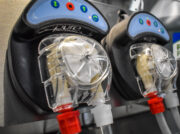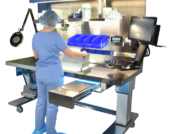
3 Outcomes of Efficiently Designed Prep and Pack Workspaces
Packaging and assembly in central sterile processing departments are necessary to ensure sterility of instruments that will be used on the next patient. During that process, technicians are responsible for inspection, assembly, and packaging of instruments in preparation for sterilization. It is a critical step that requires acute attention to detail. Efficiently designed prep and pack workspaces lead to benefits not only for your team, but patient safety.
1. Employees can be more actively engaged in tasks
Visual inspection of instruments following the decontamination process is vitally important to ensure removal of any residual debris or instrument damage. To achieve adequate visual inspection, departments must be outfitted with equipment to assist technicians with performing their tasks.
Visual inspection according to ANSI/AAMI ST79:2017, Annex D, Verification of cleaning processes involves “the use of a lighted magnifying glass for inspecting cleanliness of device surfaces or the use of borescope cameras for inspecting the internal channels of lumened instruments. Health care personnel inspect every device for visible organic soil and contamination in a simple functionality check, usually as part of the inspection, preparation, and packaging procedure.”
When employees are outfitted with tools such as sufficient overhead lighting, magnified task lights and borescopes, they are able to effectively perform their job and can do so without visual strain.
2. Ergonomic considerations improve employee safety
Trays full of decontaminated instruments that are packaged for the next surgical procedure can become an ergonomic injury risk. A major orthopedic case can take 30 instrument trays, some weighing as much as 40 pounds.1 Lifting trays creates distress on technicians’ musculoskeletal system. When compounded with the twisting and lifting of trays onto a packaging and assembly table, your staff are at risk for added injuries.
One way to avoid ergonomic injuries is to design a workspace that incorporates the needs of the user. Height-adjustable prep and pack tables help technicians by allowing them to adjust the table height to their needs and tasks. Packaging and assembly require the technician to carefully sort and place instruments into trays. This process can become tedious and painful when the prep and pack table is either too high or too short for the technician. Add the inability to properly reach the supplies needed to prepare the tray for packaging, and you create even more strain. That’s where pegboards attached to height-adjustable tables help users not only perform their duty with more ease, but do so with more attention to detail and efficiency, without the burden of bodily pain.

3. Design helps meet patient safety goals
Once instruments are inspected and sorted and placed into trays, packaging of the instruments creates a protective barrier to ensure sterility between the sterilization process and when those instruments are used on the next patient. Any irregularities or punctures in sterile wrap put the patient at risk for a healthcare acquired infection (HAI) by allowing contaminants to enter through the sterile wrap. To avoid this scenario, ANSI/AAMI ST79:2017, 9.1 standards state that “…sterile processing personnel should …inspect wraps before each use for holes, worn spots, and stains. …to ensure that it is free of defects that could have an adverse effect on the performance of the material.”
HSPA’s Central Service Technician Manual recommends that woven fabrics “…must be inspected to ensure that there are no tears, punctures, worn spots or stains from previous use. That inspection is performed using a light table that has a light source built into the tabletop to help spot small holes and punctures. As the wrap is passed over the lighted table top, light shines through the small holes and punctures making them easier to identify.”
To ensure that sterile wrap materials are properly inspected through the use of a tabletop light, departments must design their packaging and assembly areas with tables that allow for these recommendations and standards to be met. A prep and pack table with a built-in light allows for the exceptional inspection of sterile wrap and therefore leads to sterility assurance and improved patient safety.
Your staff are your most valuable assets. By ensuring they are able to perform their duties without injury and strain and can do so with attention to detail, patient safety is improved.
Learn more about packaging and assembly tables, such as the PureSteel Ergonomic Workstation, that can meet or exceed standards and recommendations.
Does your department have a challenge regarding prep & pack design? We’d love to help you solve it.
References:
- https://www.ormanager.com/wp-content/uploads/pdfx/ORMVol24No2instrumentSetsShedPounds.pdf
- https://webstore.ansi.org/standards/aami/ansiaamist792006?gclid=CjwKCAjw87SHBhBiEiwAukSeUSiu2D6jYVWFvtaepel09DOmZKMxzJUu3ku1pYez-NMlbf2VRKlaUhoCzpsQAvD_BwE
- Sterile Processing Technical Manual – Healthcare Sterile Processing Association (myhspa.org)



